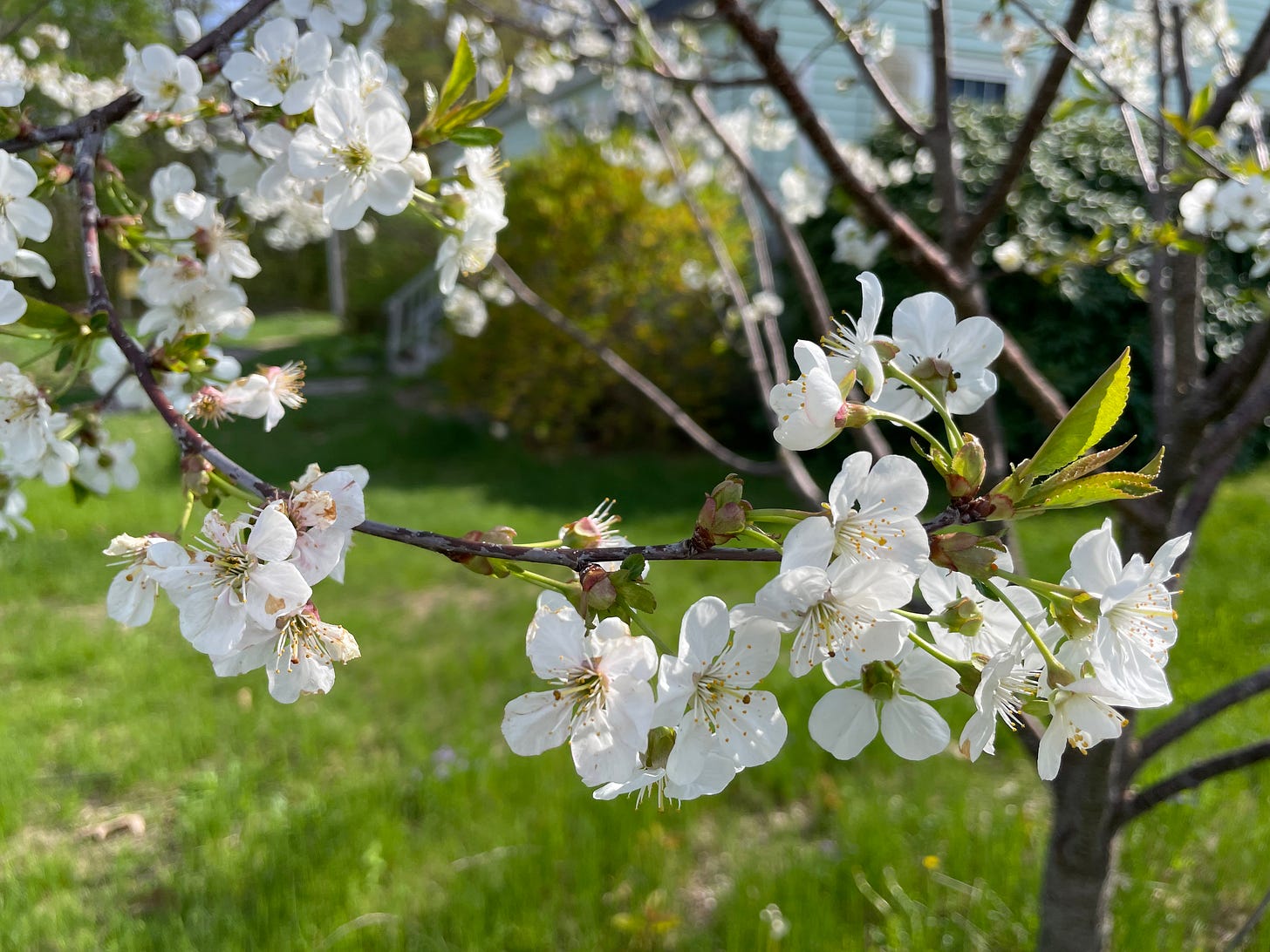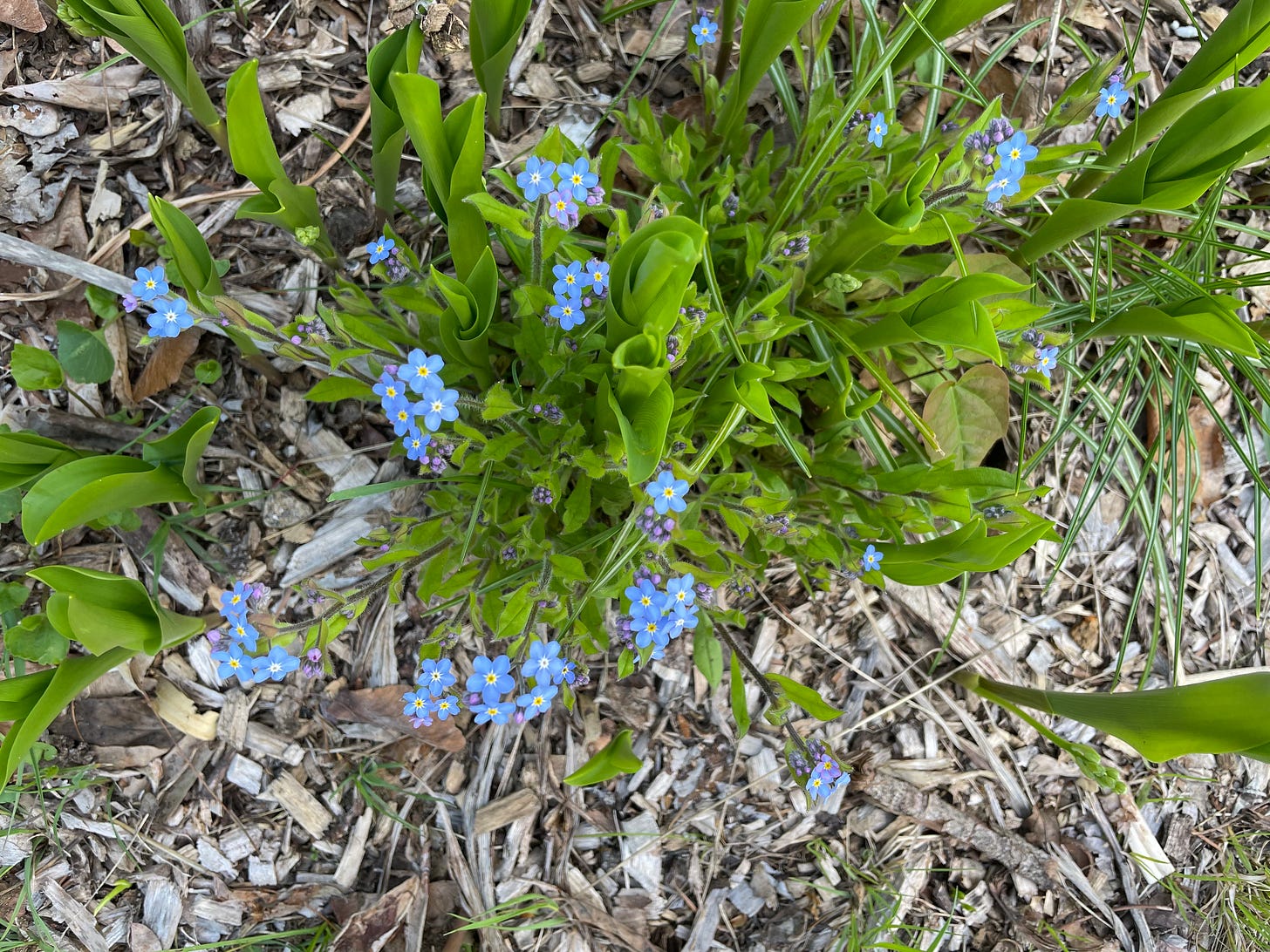Paying Attention Regularly
Writing about the seasons and observing my garden helps me to learn more about life.
At the moment, which I suspect will be fleeting since it has been raining all week and there is more to come, the sun is shining. The grass is a vibrant green far more potent than the pale spring green crayon invented by Crayola. The daffodils are blooming very yellow and pale yellow, double petals, white petals with orange centers and more.
The forsythia bushes are another shade of vigorous yellow, easily spotted while driving down the road. By the time you read this, their moment of glory as some of spring’s first flowers will be over and they will retire to a leafy green. The pear trees are blossoming and despite my worry about cold and rain, the pollinators are visiting the flowers of all the fruit trees. After so much rain, any sunshine feels like a moment to savor and celebrate.
I’ve been hauling my seedlings outside when there is a bit of sun or at least not a down pour to prepare them for their final move into the garden beds. Since I grow them under lights in my living room they need gradual exposure to sun, wind, and cooler air so they won’t be shocked when I transplant them into the soil.
Writing about the seasons and the way they emerge and shift and fade, the predictable and surprising weather that they bring, is, for me, an easeful moment of observation. Returning to the familiar temperatures, colors, sights, and sounds after being away for a year allows the seasonal changes that happen again and again to feel delightful, comforting, and reconnecting. I dip into writing about what is happening outside my window regularly for this newsletter as a chance for some calm moments and time for being here and observing now. Noticing where the robins have build their nest, the tiny buds on the lilac bushes, and where the sun set hits the interior walls of the house happens when I take time to look up and around, paying attention regularly.
This is the busy part of spring when all of the garden beds need to be weeded and mulched again, readied for seeds and seedlings. I spend too much time thinking about how I should be writing or working in the garden when I am doing neither. Luckily, my garden reminds me over and over that most of the tasks that seem way too difficult, almost impossible, are really not that bad once I just start.
Every year the strawberry patch is thick with violets, clover, quack grass, sorrel, and of course I’ve let the milkweed spread everywhere so now I pull it up when I see it. My strawberry bed that is less strawberries and more violets, lupine, poppies, and chives, feels overwhelming to maintain. Once I start weeding a little at a time, not getting every leaf and root, I remember that I can do this and I’ll do it again in several weeks when the weeds are again taking over.
On the only sunny day of last week, I kicked off my shoes and walked through the warm grass with a tray of seedlings. My onion seedlings are always on the puny side, but I still plant the long strands, thinner than spaghetti from root to fine green stem. I push the straw mulch aside and my right pointer finger dives into the soil to make a little hole. Left hand pushes the onion or cluster of onion seedlings in and I pinch the soil firmly around it. Keep going one by one until the beds of onions and shallots are planted.
I’ve noticed that people feel intimidated or overwhelmed by trying to grow a garden. Most gardens require some attention but most plants will grow where you plant them. Most years one crop will struggle or give up but most of what I plant will do well enough. Last year we had woodchucks to contend with but it didn’t become the disaster I feared. I never take it for granted that my seeds will grow and flourish, but most of the time they do.
A garden is an ecosystem within larger ecosystem. Weather, precipitation, soil, animals, insects, plants and roots are some of the variables that combine to make it all work. And then I’m there, imagining I need to manage it all. My support and interference really does help some of the plants like the tomatoes that are easier to harvest and less prone to disease when I trellis them. But they would still make plenty of fruit even with their vines sprawled across the ground, oblivious to my to do lists and worries about getting things done.
I can’t help but come back to gardening as a metaphor for life. My garden is there to remind me that things can flourish without my control. I am learning to believe that we can plant seeds and tend seedlings in our lives but a lot of what happens after that depends on the weather, the ecosystem, the soil.
What makes a successful garden season? I don’t measure it in how much I harvest or preserve, though I appreciate whatever I end up putting in the freezer and pantry. When I really think about it, I don’t actually qualify or quantify whether or not the garden season was successful. I enjoy the way it progresses from spring to summer to fall. The excitement of the first lettuce harvest, the all we can eat cucumbers, hoping for pumpkins.
This is why I look to my garden, the beds I built with sheet mulching and loads of compost, the annual plants I start from seed every year, the perennials that I love to see growing and spreading, flowers, trees, and shrubs and all the grasses and weeds in between. I have worked hard to create areas of plants that surround my house and create enjoyable spaces. I’ve planted them feet from my front door, within view of the kitchen window, in places I get to stroll by whenever I go outside and along a meandering walk to the other side of the yard. Maybe a garden isn’t the same as life, but here I am reminded that measurements of success might be irrelevant when I am enjoying the progress, appreciating what comes, and spending plenty of time with bare feet in the grass.
What creative practices, connections, rituals, or places feel supportive to your perspective on life and living?
Warmly,
Anna






I really enjoyed this meander through your spring garden. I’m in tbe southern hemisphere so it’s autumn here. I loved your ruminations about what ‘success’ looks like and so agree that it’s mostly about a chance to connect and watch the seasons change. My garden ‘talks’ to me (if that doesn’t sound too nutty) and whenever I fret about bits I’ve neglected…the garden laughs at me and says ‘don’t worry about us, we’re just fine’. I think our gardens like us better when we’re a bit loose and haphazard. Then it (garden) gets to flourish and romp in ways we try to tame.